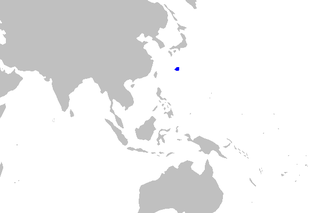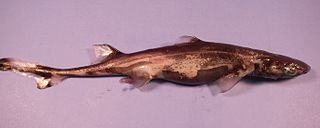
The black dogfish is a species of dogfish shark in the family Etmopteridae. It is common over the outer continental shelf and continental slope at depths of 180–2,250 m (590–7,380 ft). Females generally inhabit deeper water than males, and depending on the region, smaller sharks may occur at different depths than larger ones. This species is distributed widely in the Atlantic Ocean, from Greenland and Iceland to Virginia and West Africa in the north, and off southwestern Africa and Argentina in the south. The largest member of its family, the black dogfish, typically measures 60–75 cm (24–30 in) long. It has a stocky, dark brown body that is darker below than above, and bears scattered, minute bioluminescent organs. Its two dorsal fins are preceded by stout spines, and the anal fin is absent.

The blackbelly lanternshark or lucifer shark is a shark of the family Etmopteridae found around the world in tropical and temperate seas at depths between 150 and 1,250 meters – the mesopelagic zone. Compared to other mesopelagic fish predators and invertebrates, the blackbelly lanternshark is thought to reside in shallower, more southern waters. E. lucifer can reach up to 47 centimeters in length and consumes mesopelagic cephalopods, fish, and crustaceans. Blackbelly lanternsharks are bioluminescent, using hormone controlled mechanisms to emit light through ventral photogenic organs called photophores and are presumed to be ovoviviparous. The blackbelly lanternshark has been classified as "Not Threatened" within the New Zealand Threat Classification System.

The New Zealand lanternshark is a shark of the family Etmopteridae mainly found off the coast of New Zealand. It can also be found in the Southern areas of Australia and Africa, inhabiting water depths between 500-1500m. These sharks can be commonly known as Baxter's dogfish and giant lantern shark. According to the New Zealand Threat Classification System (NZTCS), this species conservation status is considered non-threatened.

The rasptooth dogfish is a dogfish, found on the Kyushu–Palau Ridge in the northwest Pacific Ocean at depths of 360 m. Its maximum length is unknown. This species was originally described as Centroscyllium sheikoi, and subsequently allocated to the newly named genus Miroscyllium based on anatomical features not shared with other Centroscyllium. More recent molecular data suggest this species belongs to the genus Etmopterus, but as of June 2014 Miroscyllium sheikoi remains the valid name recognized by FishBase, the Catalog of Fishes World Register of Marine Species, and the IUCN

The viper dogfish or viper shark is a rare species of dogfish shark in the family Etmopteridae, and the only extant member of its genus. It has been found in the Pacific Ocean off southern Japan, the Bonin Islands, Pacific Ocean off northern Taitung County and the Northwestern Hawaiian Islands. This species inhabits upper continental slopes and seamounts. It may migrate vertically, shifting between bottom waters 270–360 m (890–1,180 ft) deep during the day and upper waters less than 150 m (490 ft) deep at night. A slender, black shark reaching 54 cm (21 in) in length, the viper dogfish can be recognized by its narrow, triangular jaws and well-spaced, fang-like teeth. It also has two spined dorsal fins, dermal denticles with faceted crowns, and numerous light-emitting photophores concentrated on its ventral surface.

The Portuguese dogfish or Portuguese shark, is a species of sleeper shark of the family Somniosidae. This globally distributed species has been reported down to a depth of 3,675 m (12,057 ft), making it the deepest-living shark known. It inhabits lower continental slopes and abyssal plains, usually staying near the bottom. Stocky and dark brown in color, the Portuguese dogfish can be distinguished from similar-looking species by the small spines in front of its dorsal fins. Its dermal denticles are also unusual, resembling the scales of a bony fish. This species typically reaches 0.9–1 m (3.0–3.3 ft) in length; sharks in the Mediterranean Sea are much smaller and have distinct depth and food preferences.

Etmopterus is a genus of lantern sharks in the squaliform family Etmopteridae. They are found in deep sea ecosystems of the Atlantic, Indian and Pacific Oceans.

The blurred lanternshark is a little-known species of dogfish shark in the family Etmopteridae, found around the world in benthic and pelagic habitats from a depth of 110 m (360 ft) to over 1 km (0.62 mi) down. This shark forms the E. pusillus species group with the smooth lanternshark, which are distinguished from other members of its family by having irregularly arranged, flat-topped dermal denticles that give them a "smooth" appearance. Both species are slender-bodied with long heads, two dorsal fins bearing spines, no anal fins, and light-emitting photophores. The blurred lanternshark is larger, reaching 67 cm (26 in) or more in length. This species feeds on small squid, fishes, and fish eggs, and is ovoviviparous. It has been assessed as of Least Concern by the International Union for Conservation of Nature, because of its wide distribution and lack of threat from fishing pressure.

The smooth lanternshark or slender lanternshark is a species of dogfish shark in the family Etmopteridae, found widely in the Atlantic and Pacific Oceans. It inhabits benthic environments at a depth of 274–1,000 m (899–3,281 ft), and pelagic environments at a depth of 0–708 m (0–2,323 ft). The smooth lanternshark forms a species group with the larger blurred lanternshark, both of which are distinguished from other members of their family by small, irregularly arranged dermal denticles with a truncated shape. This species has a slender, dark brown body with an indistinct black band on the sides over the pelvic fins, and reaches 50 cm (20 in) in length. This slow-growing, ovoviviparous shark feeds on smaller squid, fishes, and fish eggs. Smooth lanternsharks are often caught as bycatch in eastern Atlantic and Japanese commercial fisheries. The International Union for Conservation of Nature (IUCN) has evaluated this species as of Least Concern because of its wide distribution and limited threats.

The velvet belly lanternshark is a species of dogfish shark in the family Etmopteridae. One of the most common deepwater sharks in the northeastern Atlantic Ocean, the velvet belly is found from Iceland and Norway to Gabon and South Africa at a depth of 20–2,490 m (66–8,169 ft). A small shark generally no more than 45 cm (18 in) long, the velvet belly is so named because its black underside is abruptly distinct from the brown coloration on the rest of its body. The body of this species is fairly stout, with a moderately long snout and tail, and very small gill slits. Like other lanternsharks, the velvet belly is bioluminescent, with light-emitting photophores forming a species-specific pattern over its flanks and abdomen. The ventral photophores are thought to function in counter-illumination, which camouflages the shark against predators and prey. The bioluminescent flank markings may play a role in intraspecific communication.

The green lanternshark is a species of dogfish shark in the family Etmopteridae, found in the western central Atlantic Ocean. This species usually occurs on the upper continental slope below a depth of 350 m (1,150 ft). Reaching 26 cm (10 in) in length, the green lanternshark has a slender body with a long, thin tail and low, conical dermal denticles on its flanks. It is dark brown or gray with ventral black coloration, which contain light-emitting photophores that may serve a cryptic and/or social function. Green lanternsharks are thought to be gregarious and may attack their prey, squid and octopus often larger than themselves, in packs. Reproduction is aplacental viviparous, with females giving birth to litters of one to three young. This relatively common shark is an occasional, valueless bycatch of commercial fisheries; currently it does not appear to be significantly threatened by human activities.

The Hawaiian Lanternshark is a species of small squaliform shark in the family Etmopteridae.

The dwarf lanternshark is a species of dogfish shark in the family Etmopteridae and is the smallest shark in the world, reaching a maximum known length of 20 cm (8 in). It is known to be present only on the upper continental slopes off Colombia and Venezuela, at a depth of 283–439 m (928–1,440 ft). This species can be identified by its small size at maturity, long flattened head, and pattern of black ventral markings and a mid-dorsal line. Like other members of its genus, it is capable of producing light from a distinctive array of photophores. Reproduction is aplacental viviparous, with females gestating two or three young at a time. The dwarf lanternshark is not significant to commercial fisheries, but could be threatened by mortality from bycatch; the degree of impact from human activities on its population is unknown.

The southern lanternshark is a shark of the family Etmopteridae found in the southeast Pacific between latitudes 29°S and 59°S, at depths of between 220 and 1,460 m. This species has been found off Northland, off the Chatham Islands, on the Campbell Plateau, all in New Zealand waters. Its length is up to 60 cm. Reproduction is ovoviviparous, with 10 to 13 pups in a litter, length at birth about 18 cm. They exhibit bioluminescence.

The great lanternshark is a shark of the family Etmopteridae found in the northeast and northwest Atlantic. Its name was given because, at the time of its discovery, it was thought to be bioluminescent, but this has been challenged.

The splendid lanternshark is a shark of the family Etmopteridae found in the western Pacific at depths between 120 and 210 m. Through the classification of Etmopterus species into several clades based on the positioning of their bioluminescent photophores, the splendid lanternshark can be considered a member of the Etmopterus pusillus clade.

The brown lanternshark or bristled lanternshark is a little-known species of deep-sea dogfish shark in the family Etmopteridae. It is found off Japan and New Zealand, and possibly also South Africa and Australia, typically deeper than 300 m (980 ft). This species can be distinguished from other lanternsharks by its coloration, which is a uniform dark gray or brown without the ventral surface being much darker and clearly delineated from the rest of the body. The brown lanternshark feeds on small bony fishes, cephalopods, and crustaceans. Reproduction is ovoviviparous, with females giving birth to 9–18 young. An unusually high proportion of individuals in Suruga Bay are hermaphrodites, with both male and female characteristics.

The blackmouth lanternshark is a species of dogfish shark within the family Etmopteridae. This species is part of a subgroup that includes one other species from within the family. It is known to inhabit the benthic zones of the Eastern Indian Ocean and the Arafura Sea. These sharks were first described in a 2002 issue of Cybium, and there is still much unknown about the species.

The ninja lanternshark is of the family Etmopteridae, found in the eastern Pacific Ocean from Nicaragua, south to Panama and Costa Rica. The depth range of collections is from 836 to 1443 meters along the continental slope. E. benchleyi is the only Etmopterus species presently known from the Pacific Coast of Central America.



















